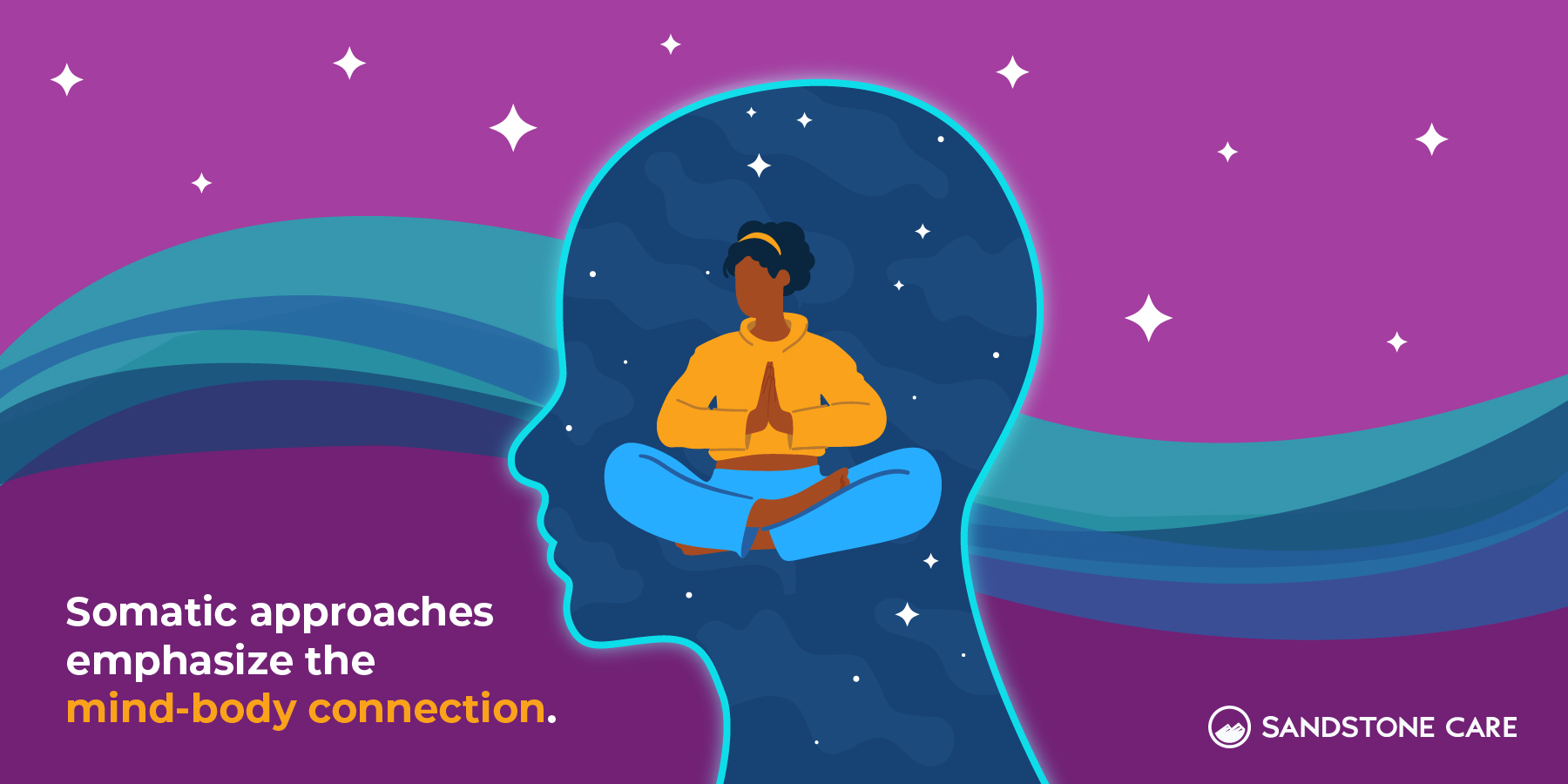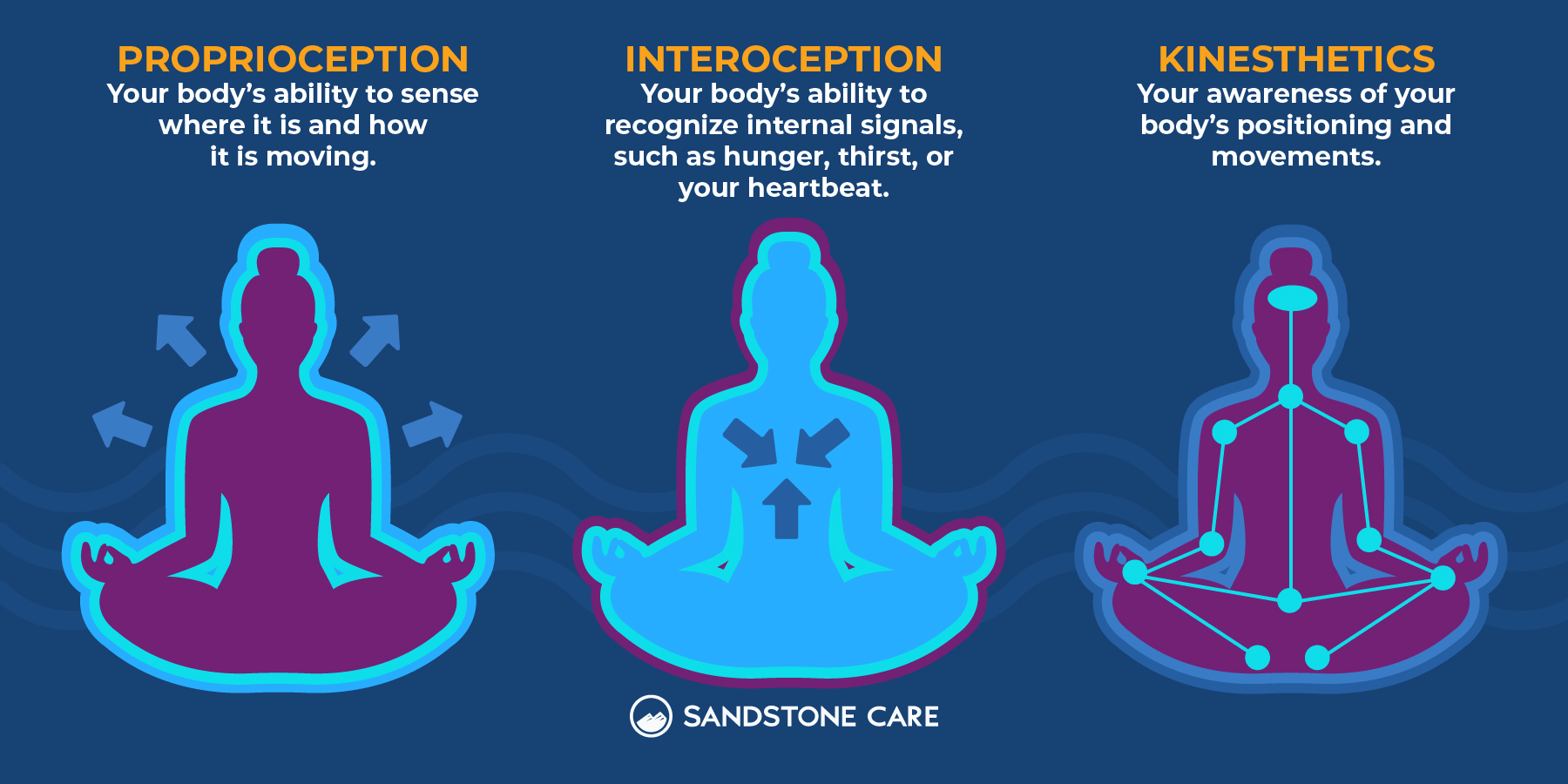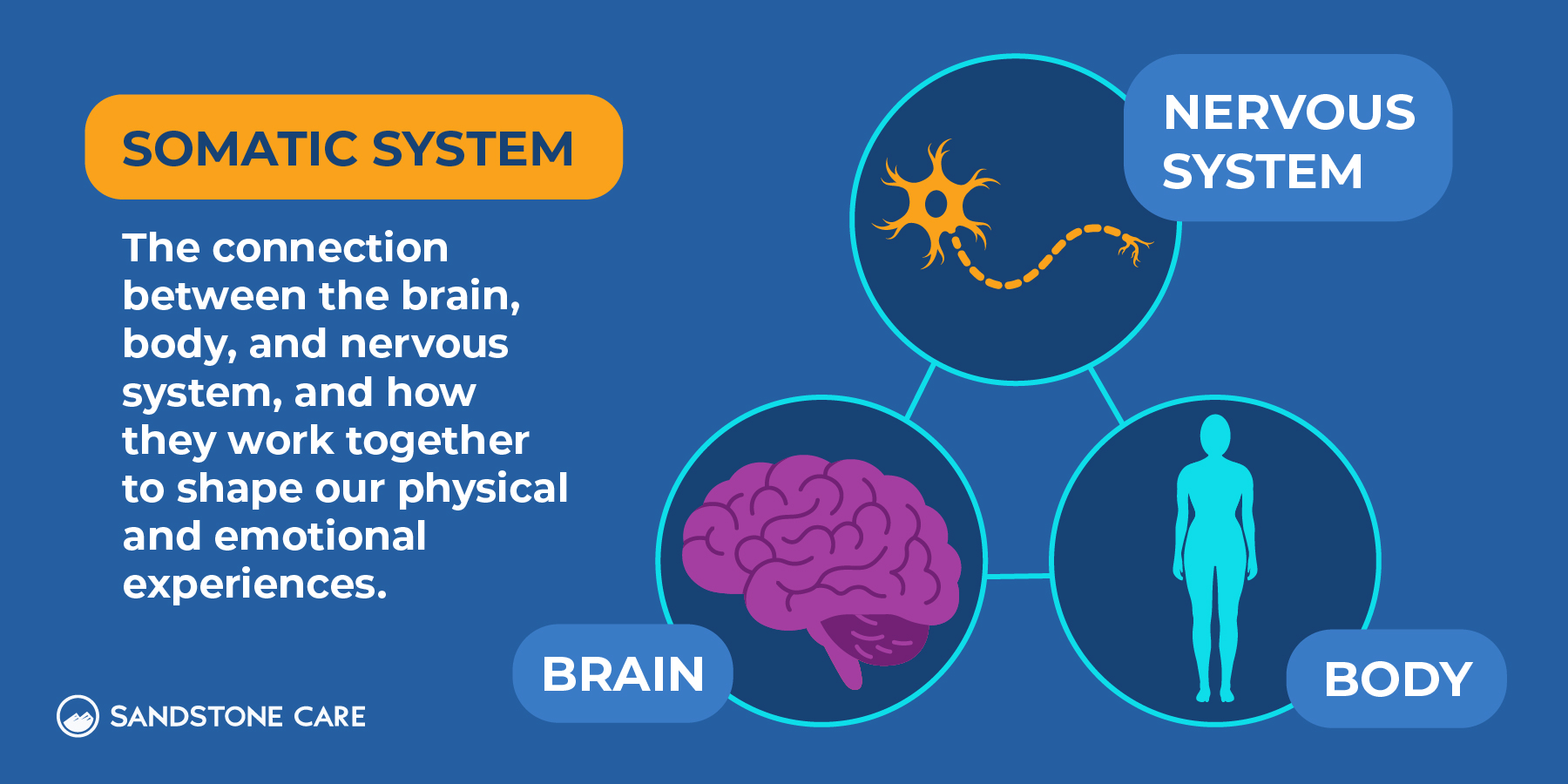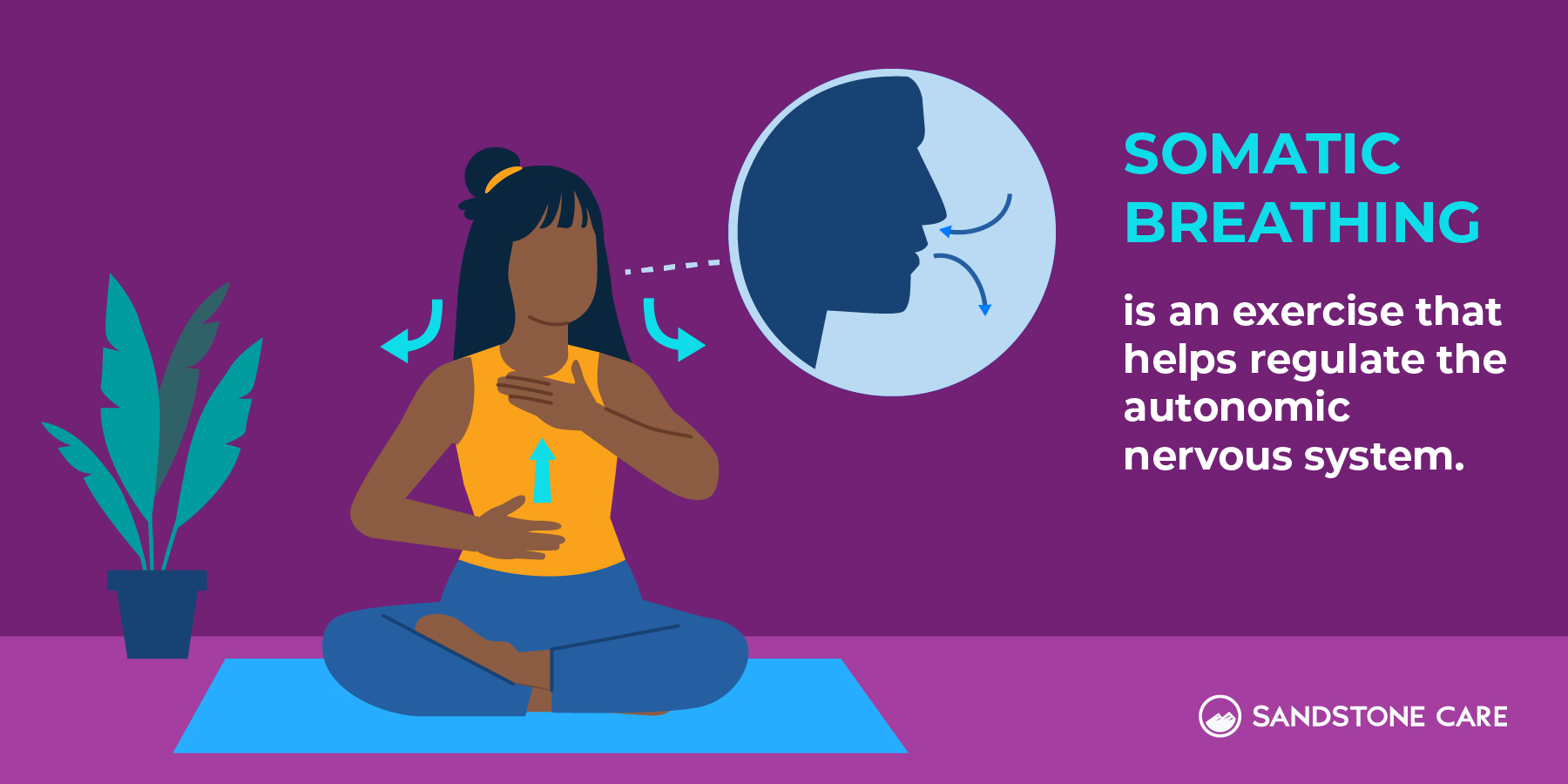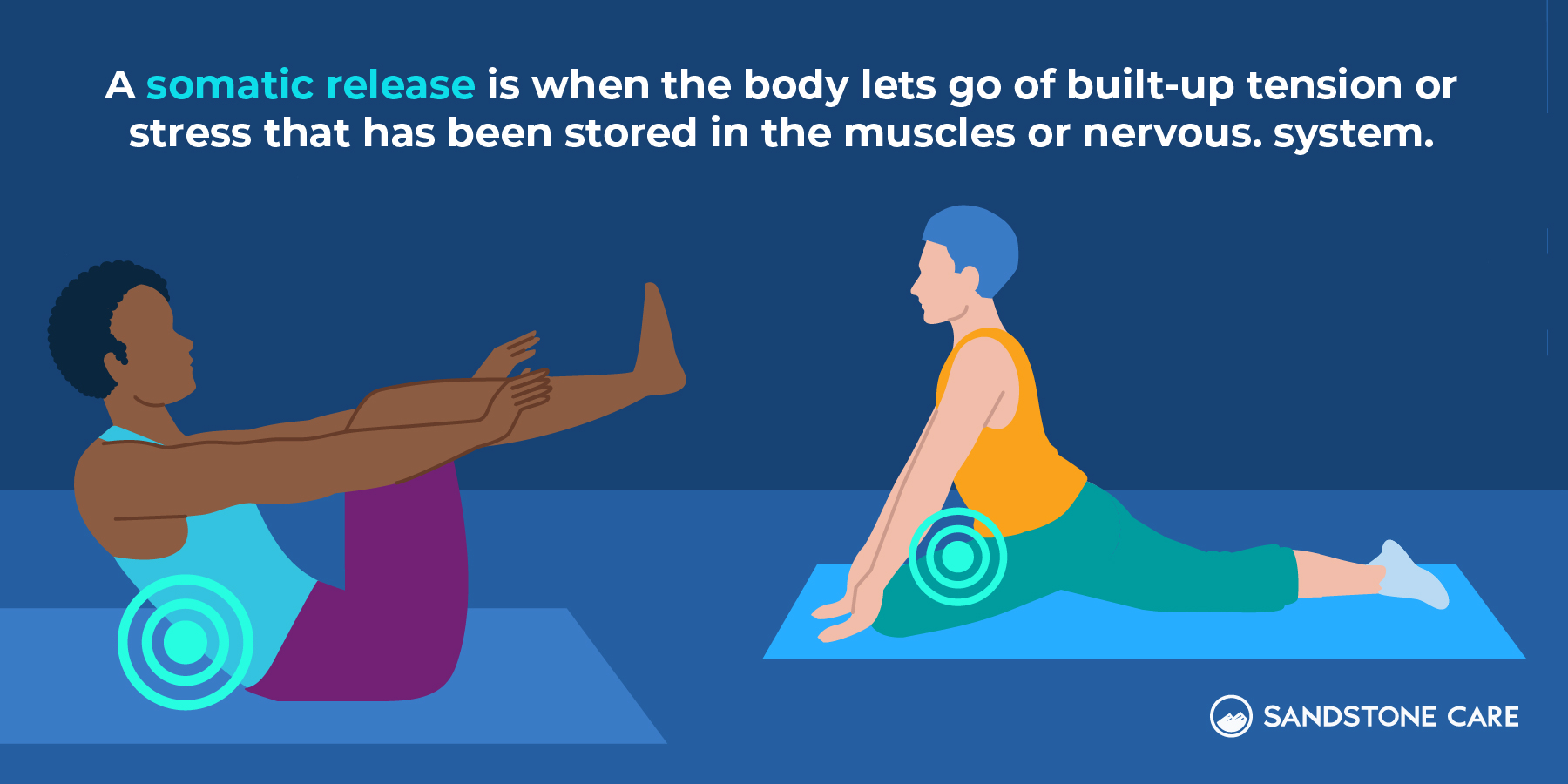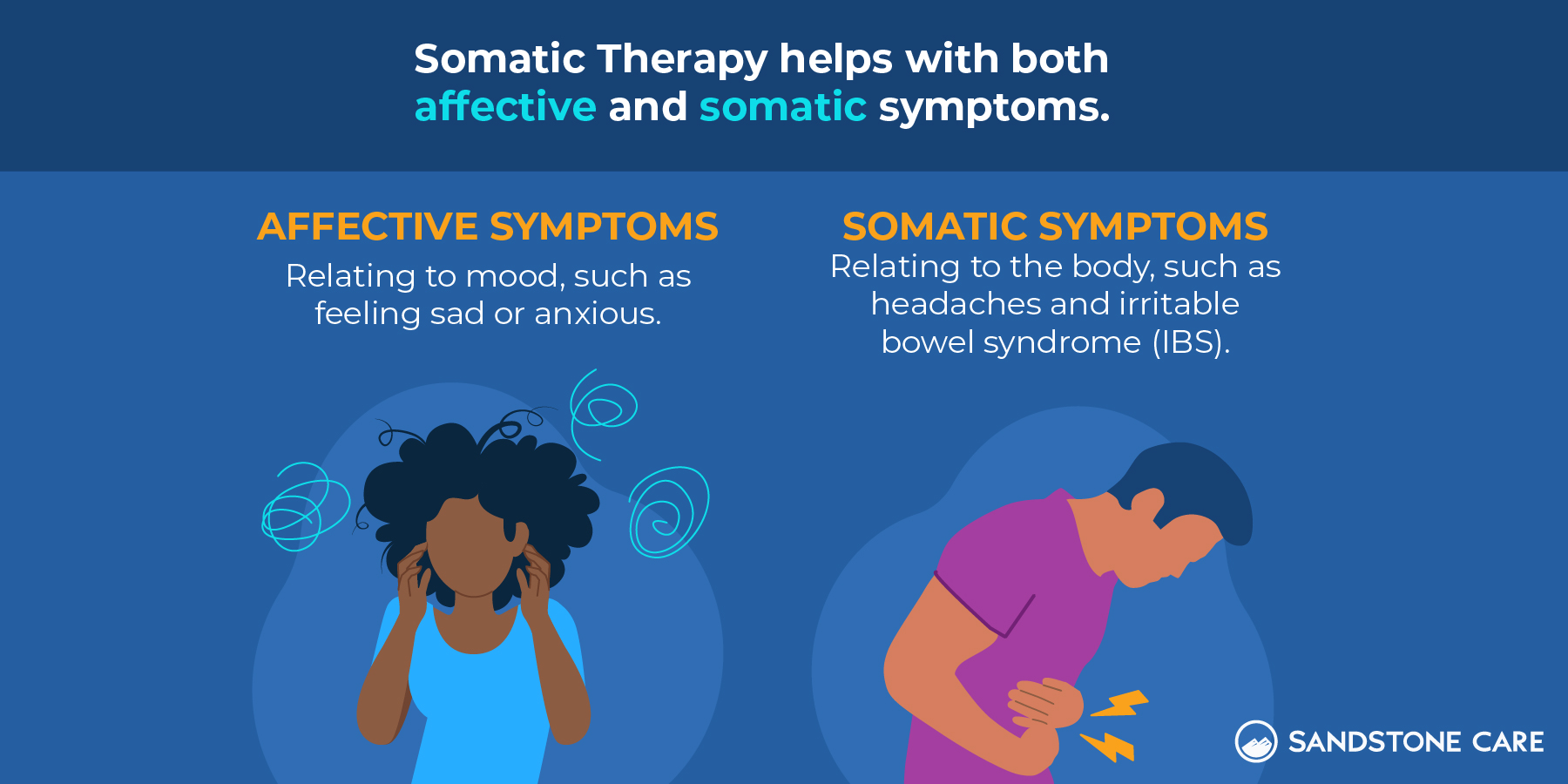What is Somatic Therapy?
Somatic therapy, also referred to as somatic experiencing therapy, is a type of therapy that is centered around the connection between the mind and body.
Psychotherapy and physical therapy are both used in somatic therapy to help heal a variety of different ailments and conditions, including:
- Stress
- Trauma
- Depression
- Anxiety
- Addiction
Somatic therapy uses mind-body techniques to help release stress, trauma, and tension that has become “locked away” in the body. By learning to self-regulate, patients are able to focus on healing trauma with the help of a mental health professional.
When a person goes through something overwhelming, some studies suggest that their body may hold on to tension, stress, or physical sensations linked to that experience.
Somatic therapy helps clients pay attention to these physical cues, such as tightness in the chest, shallow breathing, or restlessness, and use body-based techniques to release them.
These techniques may include things like grounding, yoga, or breathwork exercises.
Does Somatic Therapy Actually Work?
While there is some skepticism around somatic therapy as a whole, many people feel differences immediately after their first somatic therapy session.
Some people are skeptical of somatic therapy because it differs from more established, traditional approaches like cognitive behavioral therapy.
Since somatic work often involves paying attention to bodily sensations, movement, or breath, critics argue that it can seem vague, unscientific, or hard to measure.
Unlike talk therapy, which produces clear verbal exchanges, somatic therapy may rely on subtle physical shifts or internal awareness, which can make progress harder to track or standardize.
However, many experts note that somatic therapy carries very little risk, since it focuses on gentle techniques that can be adjusted to a person’s comfort level.
Somatic therapy also involves strategies that have been long-proven to help with mental health, such as exercise and paying close attention to your surroundings.
Research is ongoing for somatic therapy. While results of several studies show promising results for trauma-related conditions, such as post-traumatic stress disorder (PTSD), more research is needed.
Somatic therapy hasn’t been as heavily studied as other therapy types, such as cognitive behavioral therapy (CBT) or dialectical behavior therapy (DBT).
However, the results of new research studies are promising, showing that the mind-body connection may help people process experiences that talk therapy alone hasn’t been able to reach.
What is Somatic Connection?
The mind-body connection, or the somatic connection, refers to the way your thoughts are connected to your feelings.
“Feelings” imply a physical sensation that is felt in the body.
The way a person thinks impacts the way they feel, and vice versa.
So, with this idea, when a person is experiencing negative thoughts, it will impact their mind and their body as well.
This idea that the mind and body are connected opens up a pathway to healing that can be used for trauma, stress, anxiety, addiction, and other mental health disorders.
What is the Goal of Somatic Therapy?
The main goal of somatic therapy is to help a person increase awareness of the physical sensations that come from their mental health conditions and use this awareness to release tension, stress, and trauma and find healing.
What Is the History of Somatic Healing?
The history of somatic healing starts with Thomas Hanna, who named the concept of “somatics” in the 1970s when he created one of the first schools focused on the mind-body connection.
Other influential individuals include Wilhelm Reich, Peter Levine, and Bessel van der Kolk.
Wilhelm Reich: A psychoanalyst who explored the mind and body connection. He focused on how emotional stress often manifested as physical tension, coining the term “character armor”.
Peter Levine: He built off the work of others, such as Wilhelm Reich, and pioneered Somatic Experiencing. Part of his work was influenced by observing how animals recover from repeated traumatic events.
Bessel van der Kolk: He is a psychiatrist who wrote on how trauma is stored in the body and often manifests as physical symptoms. He is the author of The Body Keeps the Score, a popular book on the topic.
Throughout the 1970s, 80s, and 90s, various somatic therapy interventions emerged and are still used today, integrated into modern forms.
While different types of somatic therapy have been used for centuries, all of them have in common the belief that the body is connected to the mind and can help heal a person facing challenges with their mental health.
What Does Somatic Mean?
The term “somatic” comes from the Greek word soma, which means “the living body”. In therapy, it refers to focusing on how the body holds and expresses emotions and trauma.
Somatics can also refer to proprioception, interoception, and kinesthetics, and how they can help people understand their emotional reactions, traumas, and experiences with their mental health.
Proprioception is external bodily awareness. It is your body’s ability to sense where it is and how it is moving.
Interoception is internal bodily awareness. It is your body’s ability to recognize internal signals, such as hunger, thirst, or your heartbeat.
Kinesthetics refers to the perception of body movements and awareness of your body’s positioning and movements.
Sometimes the word “somatic” is used to describe anything related to the way the mind and body affect each other.
What Is a Somatic System?
A somatic system refers to the connection between the brain, body, and nervous system, and how they work together to shape our physical and emotional experiences.
When something stressful or traumatic happens, the nervous system can store that experience in the body through muscle tension, changes in breathing, or other physical reactions.
Over time, these patterns may remain even after the threat has passed, leaving the body “stuck” in survival mode.
Instead of focusing only on thoughts or memories, therapists guide clients to notice where in the body stress or trauma is held, such as a tight chest, clenched jaw, or restless legs.
Traumatic experiences are not be literally held in the legs or chest, but the term “holding trauma” is a helpful way to direct your attention to places where your body is tense or on edge because of the anxiety, nervousness, or burnout that comes from a traumatic experience.
By gently working with these sensations through awareness, movement, and grounding techniques, the body is given the chance to relax muscles that were tensed unintentionally.
What Are the Different Types of Somatic Therapy?
Four of the more common types of somatic therapy are somatic experiencing, sensorimotor psychotherapy, the Hakomi method, and body psychotherapy.
- Somatic experiencing (SE), pioneered by Peter Levine in the 1970s, aims to resolve trauma that is stored in the body.
- Sensorimotor psychotherapy, developed by Pat Ogden in the 1980s and 1990s, involves integrating mindfulness and movement with psychotherapy. It combines ideas from both cognitive behavioral therapy and neuroscience.
- Hakomi method, developed by Ron Kurtz in the 1970s, centers around the practice of mindfulness and focuses on how we live in our bodies to promote wellness.
- Body psychotherapy or body modalities are broad terms and include practices such as massage, movement therapy, and somatic yoga.
Somatic Therapy Exercises
What Are Some Somatic Therapy Exercises and Techniques?
Somatic activities involve movement that helps a person bring awareness to the connection between their mind and body.
Some common mind-body exercises can include:
- Dance
- Somatic yoga
- Breathing exercises
- Mindfulness
More focused somatic exercises for trauma and somatic exercises for anxiety may include:
- Body scanning to bring awareness to bodily sensations happening both internally and externally
- Somatic breathing to help regulate the autonomic nervous system (the nervous system that helps to regulate involuntary functions such as breathing, heart rate, and digestion)
- Somatic shaking (gentle tremors) to help relax “tension trauma”
- Resourcing, which is practicing the ability to recall safe or positive emotional experiences
What Is Somatic Yoga?
Somatic yoga is a gentle style of yoga that focuses on becoming more aware of how the body feels, moves, and holds tension.
Instead of focusing on flexibility or appearance, somatic yoga encourages awareness of what’s happening inside the body. This can be especially helpful for people who have experienced stress or trauma and are working to feel more connected and safe in their bodies again. Movements are small, slow, and done with attention to how each one feels.
Early research shows that somatic yoga may reduce symptoms of depression, anxiety, and post-traumatic stress disorder (PTSD), but more studies are needed to know how effective it truly is. It can be a useful tool for calming the body and mind, but it’s not a replacement for therapy or other proven treatments.
Does Somatic Stretching work?
Yes, somatic stretching can help calm the nervous system, improve mobility, reduce the physical symptoms of stress.
Similar to somatic yoga, somatic stretching helps people become more aware of their bodies and where they hold tightness. It uses slow, mindful movements to release muscle tension and improve awareness of how the body moves and responds. The focus is on gentle exploration rather than pushing for flexibility or performance.
Somatic stretching can help ease physical stress and create a sense of calm, but it isn’t a solution for everything.
While it may reduce tension in the moment, lasting change often requires understanding and addressing the root causes of stress or trauma responses.
Many people find that combining somatic practices with therapy or other forms of emotional support leads to more effective progress that lasts longer.
What Is an Example of a Somatic Workout Plan?
A somatic workout may incorporate several different types of somatic exercise, for example:
1. Somatic Breathing (5 minutes)
Practice diaphragmatic breathing, letting your stomach rise with each inhale. Try box breathing—inhaling, holding, exhaling, and holding for four counts each.
2. Body Scan Meditation (10 minutes)
Sit or lie down and slowly notice each part of your body from head to toe. If you find tension, take a slow breath and soften the area as best you can.
3. Somatic Stretching or Yoga (15 minutes)
Move gently through Child’s Pose, Cat-Cow stretches, and a Supine Twist. Focus on how your muscles feel and release tension with each breath.
4. Somatic Shaking (5 minutes)
Stand with feet apart, knees soft, and let your body shake and bounce. Allow stress to “shake off,” then pause to notice how your body feels.
Practices like body scanning, meditation, and yoga can help your mental health through the principles of somatics.
However, if you are experiencing new symptoms, worsening symptoms, or symptoms that aren’t improving with treatment, seek the advice of a medical professional.
What Is a Somatic Detox?
A somatic detox is a term some people use to describe practices meant to “reset” the body by releasing stress or emotional tension through movement, breathing, or mindfulness.
The word detox usually refers to medical or supervised programs that help the body safely clear drugs or alcohol, but in this context it’s used more metaphorically. A somatic detox focuses on calming the body and nervous system rather than removing physical substances.
These practices might include slow stretching, shaking, focused breathing, or guided medications. Some people say these techniques help them feel lighter or more present after periods of stress or emotional challenges.
However, there is no scientific evidence that emotions or trauma can actually be removed from the body like toxins. The sense of release that people feel likely comes from increased awareness, relaxation, and nervous system regulation rather than a physical “detox.”
Somatic detox activities can support stress management and self-reflection, but they are not a replacement for therapy or medical treatment.
Real healing usually involves understanding and working through the root causes of stress, trauma, or emotional pain with the help of a trained professional.
Somatic Trauma Therapy
Does Somatic Experiencing Therapy Help With Trauma?
Yes. Some studies suggest that somatic experiencing can be helpful for many survivors of trauma events because it can help to integrate past traumas without overwhelming them, especially when combined with traditional therapy.
It incorporates several key elements that help in the processing of a traumatic experience.
These elements are:
Presence: Grounding to be fully present in the moment rather than constantly flashing back to the traumatic experience.
Embodied resource: Rebuilding a sense of safety and well-being within the body
Titration: Increasing and decreasing how much trauma is addressed and released at a time.
Pendulation: Shifting between a traumatic or uncomfortable sensation and one that feels safe to help neutralize the emotional response.
Discharge: Releasing tension stored in the body from the traumatic experiences.
Biological completion: Restoring balance to the nervous system after traumatic experiences.
What Is a Somatic Release?
A somatic release is when the body lets go of built-up tension or stress that has been stored in the muscles or nervous system after difficult experiences.
For example, someone might notice their shoulders finally relax after years of being tight, or they may tremble, yawn, cry, or sigh during a therapy session.
When we’re under stress, the body activates the “fight or flight” response. The sympathetic nervous system speeds up heart rate, increases muscle tension, and sharpens focus so we can respond to a threat.
But in many situations, like an argument, a car accident, or ongoing trauma, we can’t fully fight or flee, so the stress response doesn’t finish.
Instead, the body keeps some of that tension stored.
A somatic release happens later, once the parasympathetic nervous system kicks in and signals to the body that it is no longer in danger.
Somatic release can happen through structured practices like breathing exercises, stretching, or guided therapy, but it can also occur naturally once the body feels safe enough.
What Are Signs Your Body Is Releasing Trauma?
There are several signs your body is “releasing trauma,” such as:
- Somatic tremors or shaking
- Deep sighs or spontaneous breathing shifts
- Emotional releases such as crying or laughing
- Relaxation in previously tense muscles
There are several additional signs your body is recovering from trauma and healing beyond those listed.
For example, you may notice an increase in energy, changes in your physical health such as reduced headaches, and improved sleep.
Benefits of Somatic Therapy
What Are the Benefits of Somatic Therapy?
The benefits of somatic therapy include healing trauma, improved health and well-being, as well as a greater awareness of your mind-body connection.
Additional benefits may include:
- Less chronic pain
- A reduction in panic attacks and anxiety
- Improved self-regulation
- A sense of resilience
The wide range of benefits is due to somatic therapy’s emphasis on the mind-body connection, allowing it to offer benefits to both affective and somatic symptoms.
Affective symptoms are those pertaining to mood, such as feeling sad or anxious.
Somatic symptoms are the physical symptoms pertaining to the body, such as headaches and irritable bowel syndrome (IBS).
While more research is needed, current research suggests that it has a measurable, positive impact on the well-being of individuals who have experienced trauma.
Who Can Benefit from Somatic Therapy?
Anyone who is struggling with past traumatic experiences, stress, mental health challenges, or unresolved emotional conflict can benefit from somatic therapy.
It can help those with a lot of stress find relief and healing. Additionally, it provides a different way to understand trauma and process it.
This idea that the mind and body are connected opens up a pathway to healing that can be used for trauma, stress, anxiety, addiction, and other mental health disorders.
In releasing locked-away emotions and stress, a person can improve their physical and emotional health and well-being.
Can Somatic Therapy Fix My Anxiety?
Somatic therapy can help regulate the nervous system and lessen symptoms of anxiety, but it is not an instant cure.
For example, somatic therapy is often helpful in reducing intrusive thoughts and calming the body’s stress responses, such as a racing heart or tight chest.
This can be especially useful during or after a panic attack. When panic sets in, the nervous system goes into overdrive, creating overwhelming physical sensations like shortness of breath, dizziness, or trembling.
Somatic techniques like grounding exercises, paced breathing, and guided body awareness can interrupt that cycle and help the body return to a calmer state.
However, individuals respond differently to treatment, and you may need to combine somatic therapy with other approaches to fully treat anxiety.
For some, somatic therapy works best alongside talk therapy, medication, or lifestyle changes like exercise and improved sleep.
While it is not a guaranteed “fix,” it can be a valuable tool for managing both everyday anxiety.
How Long Does it Take for Somatics to Work?
Somatics is not an instant solution, and it may take several months of consistent practice for you to feel the full benefits of somatic therapy.
However, many people notice changes in their body awareness and wellness within days to weeks of practice.
Several studies have explored the ability of somatic experiencing to help treat mental health conditions such as trauma, anxiety, and depression. Others have explored its ability to improve resilience and coping.
Overall, both short-term and longer-term interventions appear effective in improving well-being and quality of life, but more research is needed.
Finding a Somatic Therapist
What Is a Somatic Therapist?
A somatic therapist is a professional who specializes in somatic psychotherapy and integrates body-oriented methods with psychology.
Note that mental health providers specializing in somatics are first licensed as social workers, professional counselors, mental health counselors, or psychologists.
Then they take additional training in somatics. There is currently no professional license to be a somatic therapist.
Other types of therapists, such as massage therapists or yoga therapists, may offer a somatic component to their practice. For example, some yoga therapists may receive additional certification in Trauma Sensitive Yoga or Trauma-Conscious Yoga Method.
The Trauma-Conscious Yoga Method specifically utilizes principles of somatic psychotherapy in its training to provide somatic, trauma-informed yoga.
Keep in mind that while some other professions use the term “therapist” as part of their title (e.g., massage therapist), this does not mean that they are a licensed mental health care professional.
What Should I Look for in a Somatic Therapist?
Look for a somatic therapist who has a license to practice mental healthcare as well as additional training in somatic experiencing, sensorimotor psychotherapy, or other somatic approaches.
You may also consider asking a potential therapist about their experience with trauma and body psychotherapy.
Other therapies: If you are seeking other therapies like somatic yoga or massage therapy, look to see if the therapist has additional training or certifications.
There are several trainings available for different types of therapists that focus on somatics and provide education on trauma-informed and trauma-sensitive practices.
How Often Should I Do Somatic Therapy?
How often you do somatic therapy depends on how severe your symptoms are, but many people benefit from weekly or monthly sessions.
Others find that they like learning the techniques from their therapist and then practicing them mostly on their own in between sessions.
Seeing a therapist throughout your healing journey however, can help you to make sure you are making progress, finding root causes, and know when it is time to try a different strategy.
How Do I Find Somatic Therapy Near Me?
Start by reaching out to a mental health provider you feel comfortable with and ask if they incorporate somatic therapy into their approach. This can be a good first step, since many therapists use a mix of methods and may already include somatic techniques in their work like breathing exercises and grounding.
While Sandstone Care is not a program focused solely on somatic therapy, our therapists recognize how closely the mind and body are connected in the healing process.
Many of our clinicians use techniques such as grounding exercises, mindful breathing, and relaxation strategies alongside evidence-based therapies like cognitive behavioral therapy (CBT) and trauma-focused care.
Our goal is to help clients understand and address the root causes of stress, trauma, or substance use while learning how these experiences affect the body. By combining talk therapy with practical mind–body tools, clients can begin to feel more stable, present, and in control of their responses.
If you or someone you care about is struggling with trauma, anxiety, or substance use, Sandstone Care can help. Call (888) 850-1890 to speak with a care advocate, or visit our locations page to find a treatment center near you.


